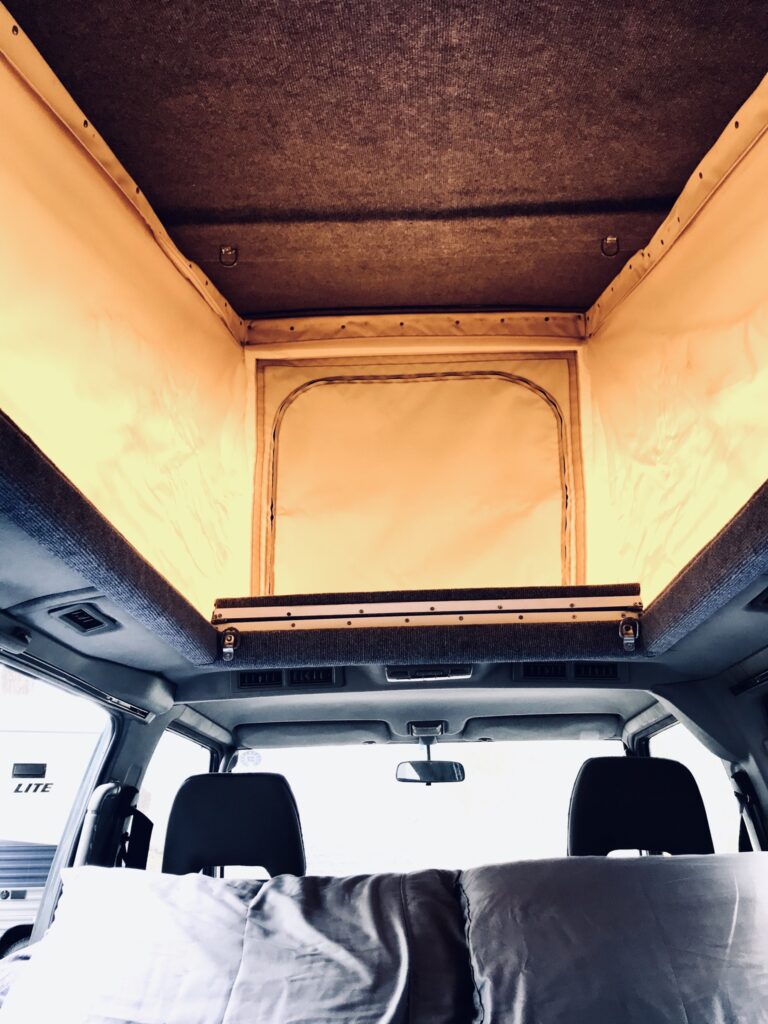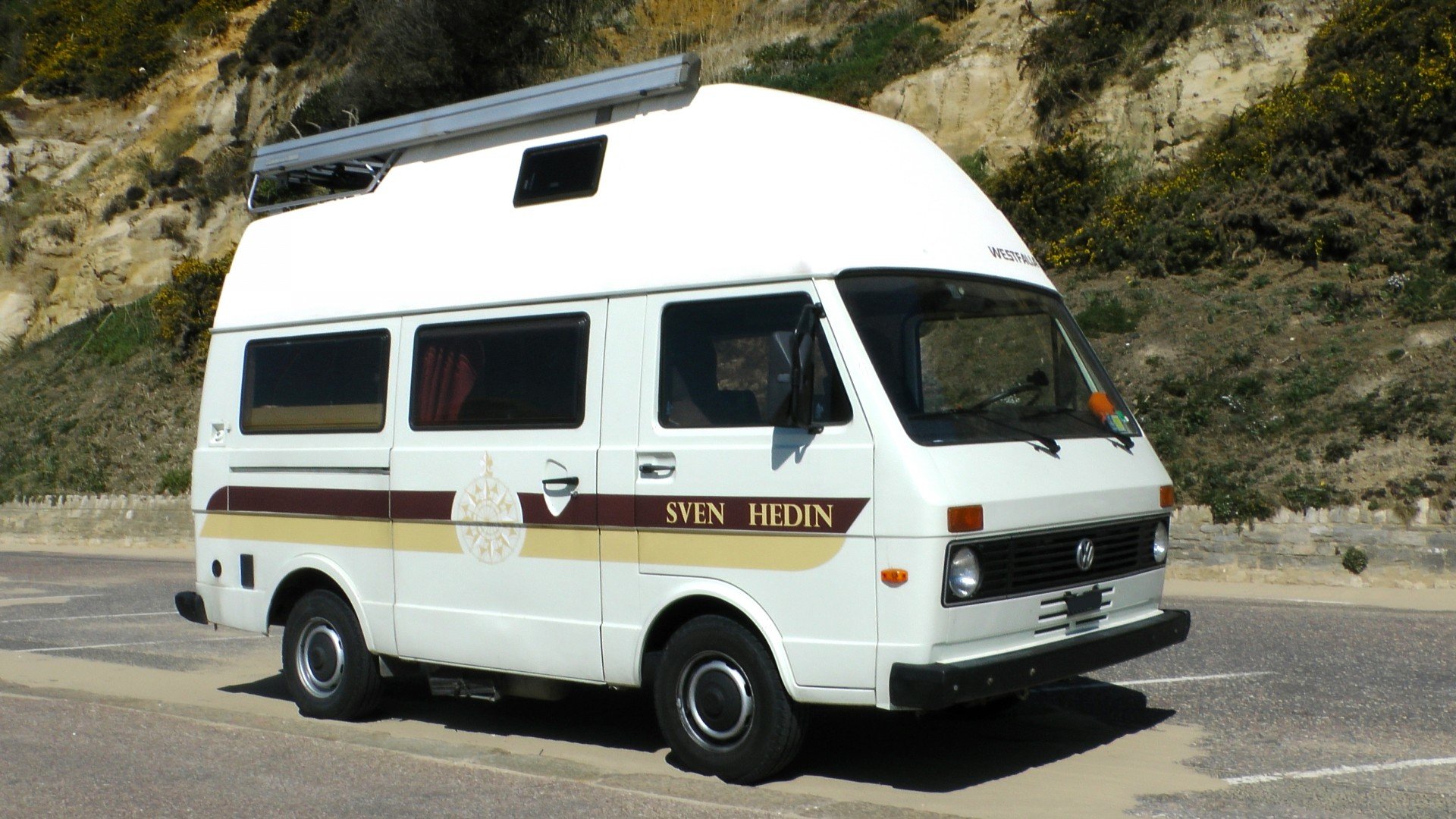CONSIDER THIS BEFORE BUYING A VAN
May 28, 2020
POP TOPS VS HIGH TOPS
In this piece I’ll describe my pop top and provide some considerations when deciding between pop-top and high-top vans.
When I began looking at vans back in 2016, I knew I wanted a pop top. After initially becoming interested in Volkswagen Westfalias, I began looking for other small vans with pop tops and discovered they weren’t too common. Unless you get one installed by a company like Sportsmobile, Glampervan, Colorado Campervan, or Outside Van, most vans don’t come with a factory installed pop top. After learning about Mitsubishi Delicas, I discovered that some (while a bit rare) have pop tops! As soon as I was able to locate two, I inquired about both of them and ended up purchasing my 1991 Delica in Vancouver, Canada.
None of my thoughts on this are rocket science, but if you’ve just started thinking about buying a van or you’re new to the van research rabbit hole, this may be helpful!
MY POP-TOP DELICA
So for my van specifically, the pop top itself adds a little height to the van, even without being extended. Like a mini high top. On the inside, with the top down, the pop top adds about 8.5 inches of headroom to the original van roof, which is pretty nice! As you see in the photo below, the extended pop-top has some decent height.

When the top is fully extended, it adds a little over 3 feet of additional space in the van, which is AWESOME. Particularly when I’m dealing with such a small space to begin with–I’ll take what I can get! Looking at the photo below, there is a wooden lip (I don’t know what else to call it) all around the interior pop-top perimeter (where the hole was cut in the roof). This is used to support the folding wooden sleeping area platform. The wooden platform lip extends around the entire pop top area, leaving approximately a 24 inch void for you to crawl up with the platform fully extended. The primary function of the pop top is to provide a sleeping area.


What I like about pop tops is that they provide some flexibility and maneuverability that high tops don’t. However, all of that is only relevant depending on what you plan to do with your van. I plan on taking my van off-roading and will do some more remote camping, so maneuverability is important to me. The pop top set-up on my van is definitely some kind of back yard aftermarket job. But it works! As of now, we are considering potentially modifying the pop top. But more on that later…
HIGH-TOP VANS
If you’re unfamiliar with high top vans, I’ve got a couple of photos below just to give you something to visualize when I’m comparing the two in the next section below.

Volkswagen high top van.

Mercedes Sprinter: These bad boys are pricey (image © outside van).

Dodge Promaster camper van by Glampervan.
CRITERIA: THE SQUARE-OFF
Below I’ve listed some criteria you might consider as you are making your decision between a pop-top and high top. They are in no particular order. I’m sure I’ve missed some things but this is the process I used to ultimately choose a pop top. I hope this helps you with your research and van selection!
Something I realized as I was writing this is that for literally every advantage a pop top has, conversely, it’s a disadvantage for high tops and vice versa. So my apologies if this seems redundant!
1. Overall Versatility
- Pop top: WIN. You can really have it both ways. And as a result, you can go more places with more maneuverability. But it comes at a cost: no permanent storage space.
- High top: LOSE. You’re a bit more limited with where you can go with a high top. But it’s marginal and may not even effect you at all if you’re not planning on going off-grid into the bush. And in my assessment, high tops win out in many other areas.
2. Storage
- Pop Top: LOSE. With a pop top, there’s no real storage space up there–permanent or otherwise. The temporary space created by a pop-top is really solely for sleeping space, headroom, or ventilation. You CAN install some rooftop storage, but the weight a pop top can support is limited.
- High Top: WIN. You’ll have a permanent space for additional storage or sleeping, depending on how you decide to set it up. Additionally, a high top will be able to support more weight with a roof rack or storage container set-up.
3. Maneuverability
- Pop Top: WIN. Better clearance! Pop-top vans have fewer issues with low branches or any overhead obstacles when boondocking or driving through far out places in the wild. Along the same vein, pop-tops make your vehicle more aerodynamic. The top comes down, therefore the vehicle is more compact.
- High Top: LOSE. Generally speaking, a high top will not be as maneuverable. You’ll need to pay extra attention to low branches, signs, overhangs, awnings, or anything else that may be in your way. You honestly shouldn’t have TOO many issues, since most bridges and highly trafficked areas have enough clearance for semi-trucks. But if you intend to take your van into the wild or off-roading regularly, you’ll need to do so with care. Something else to think about is weight distribution. High tops are top-heavy and their height can make for more difficult driving in windy conditions.
4. Structural Integrity
- Pop Top: LOSE. By nature of a pop-top not being in one piece (like a hard top), it’s less structurally sound and consequently more prone to cracks, tears, and leaks. So whether it be water leaks, more dirt/dust/grime creeping in, or problems that come along with water, like mold, these are just additional considerations to be aware of. A pop top comes with some maintenance.
- High Top: WIN. For exactly the opposite reasons. One piece. Lower probability of all of the issues listed above. Bueno. A high top also has the structural ability to accommodate additional cabinetry or storage inside with the elevated roof. And, as I mentioned before, a high top can handle more weight for rooftop storage than a pop top.
5. Safety/Security
- Pop Top: LOSE. For obvious reasons. It’s a tent. So you just have to plan accordingly. If you have to camp in an urban area or in a Walmart parking lot or truck stop, consider leaving the top down and sleeping downstairs. It’s safer and less conspicuous. This especially applies to “stealth camping,” which is camping in public or private areas legally or illegally without being detected. I haven’t necessarily seen anything from a statistical perspective that would indicate pop tops are actually targeted more by thieves or predators, but they are factually less secure.
- High Top: WIN. No explanation needed.
6. Convenience (Specifically regarding time)
- Pop Top: LOSE. You’ll have to completely disassemble the pop top and your sleeping area before movement. And then set it up again when you make camp. Depending on your set-up this can be really simple or a bit more of a pain. My van’s pop top apparatus is a bit redneck, but it works and is fairly simple. It takes less than five minutes to put the top up and the same time to take it down. Not too shabby!
- High Top: WIN. With a high top, you have permanence. The pop top is definitely a novelty. It’s cool and fun and all, especially if you’re using your van as a weekender. But if you’re actually full-time LIVING in your van, it could get pretty old having to take down/set up your sleeping area…every. single. night. (I’m about to learn that lesson here shortly) With a high top, you can wake up and just go!
7. Novelty
- Pop Top: WIN. Ok, you have to admit, these are just cool. With a pop top van you can kind of have a “tent/outdoor” experience while never having to leave your vehicle. It’s the quintessential camping vehicle. It’s neat and fun. You just have to decide how much that matters to you.
High Top: LOSE. Maybe “lose” isn’t the right word! But I just like pop tops better. This is just based on my personal preference and I do also love high tops. No explanation on this one haha!
8. Temperature Control
- Pop Top: LOSE. Just remember, a pop top is basically a canvas tent. So yes, to an extent you can control the temperature. But there’s a limit. A benefit of the pop top is increased air flow and ventilation. This can work fairly well for hot/humid camping.
- High Top: WIN. With a hard top (sometimes insulated), your vehicle’s interior temperature will be independent of the weather outside. Your van will stay cooler if you’re running the AC and it will stay warmer if you’re running the heater. Wind, rain, snow, whatever, it’s all good!
9. Noise
- Pop Top: LOSE. You’re essentially sleeping in a fortified tent. Yes, it’s partially a solid barrier, but there is a lot of surface area for sound to intrude. Get used to dogs barking, people partying, and roosters crowing!!
- High Top: WIN. High tops are a solid enclosure.
10. Cost: Time and Money
- Pop Top: LOSE. I say this for a few reasons. You can either do it yourself or pay a professional to install it. If you do it yourself, it’s going to be slow going. You have to find the parts, get the tools, and have a space to work on the pop top installation. You’re cutting into the roof of your vehicle, which is a serious operation and must be very precise. The DIY pop top kit itself will cost somewhere between $300 and $9000 depending on where you purchase it and what kind of pop top you need. Some examples are here and here and the guy in this video took on the project himself. If you pay for a professional to install a pop top on your van, it can cost upwards of $8,000!! Northwesty’s base price is $11,700. GTRV’s base price for pop top installation is between $8,500 and $10,000. And if your van comes with a pop top, you have to consider the time and money it takes for maintenance. Along with moving parts come tears, cracks, and leaks. I was lucky because I was able to find a fairly inexpensive vehicle that already had a pop top.
- High Top: WIN. These are a low maintenance, one piece, solid roof vehicle and come as the standard factory model on many, many models of vans. It won’t be a separate additional cost. Unless you’re putting your own custom high top on for some reason.
MAKING A DECISION
If you’re just beginning your research or trying to figure out what will work best for you, I recommend taking all ten of these criteria I’ve listed and any others you can think of and rank order them.
Prioritize what’s actually important to you!
For me, maneuverability was my number one priority because of the type of van traveling I want to do. My number two consideration was novelty. And I continued to rank order them from there. So, take your rank ordered list of criteria, factor in your budget and your timeline, and you should come out on the back end with a better idea of what’s best for you! Then, I’d consider renting a van for a week or two and testing your assumptions. Who knows, you may come back surprised.
I hope this information was useful. Thanks for reading!
